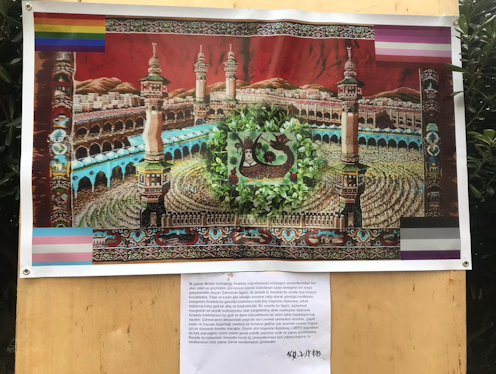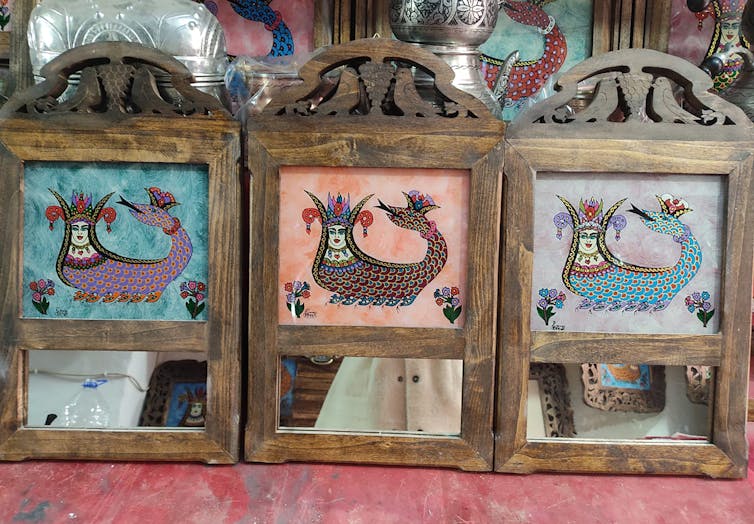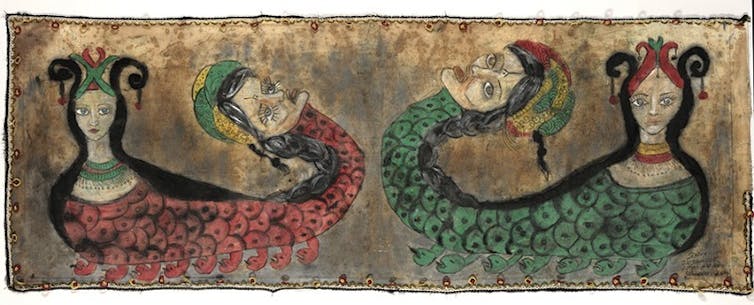What the mythical figure of Şahmeran in Turkey represents and why activists use it
Student protesters in Turkey recently used this mythical figure to express their queer identity. An art historian explains the significance.

At the center of recent protests over civil liberties and religious sensibilities in Turkey looms a half-woman, half-snake figure known as Şahmeran.
The mythical creature was included in a pro-LGBTQ poster on display at a recent exhibit at the prestigious Bosphorus University in Istanbul. Her image was superimposed over the Kaaba – a sacred black cuboid structure in Mecca that Muslims the world over face when praying.
Although the artist remained anonymous, several university students have been arrested and charged with insulting Islam in relation to the poster, which also included gender-identity flags. Accompanying the poster was a manifesto that called for respecting the rights of women, members of the LGBTQ community and nature itself.
As a scholar specializing in Islamic art history and visual culture, I was drawn by the appearance of Şahmeran’s image in these protests. Its use by young college students in Turkey who identify as LGBTQ suggest that they see this mythical creature as embodying their own identity.
The mythical protective figure
The figure of Şahmeran, meaning “Ruler of Snakes,” goes back to pre-Islamic times. Depicted with the face of a beautiful woman wearing a crown in the upper half of her body and the form of a serpent from the waist down, she is at the heart of numerous folk tales.
Although details vary, many legends tell the story of a young man named Jamasp, or Jamisav, who falls in love with the beautiful Şahmeran. Forced by a king’s evil adviser, who is also a magician, Jamasp is compelled to reveal the hideout of this mythic creature.
But tortured at seeing Şahmeran being killed, he ingests her toxic flesh to kill himself. Instead, Şahmeran transmits her wisdom to him, while her venom kills the king’s adviser. The tale’s ending thus suggests potential redemption for a breach of trust.
Recited by storytellers in both the Turkish and Kurdish languages, these tales convey Şahmeran’s ability to cure illness, provide long life and impart wisdom.
Her legends are especially popular in the eastern Anatolia region of Turkey and among Kurds, an ethnic minority comprising approximately 15% to 20% of the population in Turkey. In the southeastern Turkish city of Mardin, where there is a diverse population comprising Kurds and Arabs, there are workshops where artists specifically produce images of Şahmeran. These images, as I noticed during my visit to the city a few years ago, appear on wooden panels, metal platters and mirrors.

Some people hang paintings of Şahmeran on their walls to protect their homes or wear the image on ornaments for good fortune. Such images are also popular as amulets, much like the five-digit hand, also known as the Hand of Fatima, and blue glass beads or nazar boncuğu believed by some individuals to avert the evil eye.
Activism and composite creatures
In more recent years, mythical figures such as Şahmeran and others have been used by activists in the Middle East to raise their voices on several issues.

For example, in 2016 Şahmeran was depicted by Zehra Doğan, a Kurdish journalist and artist, as a double image, each with two heads, to symbolize the redoubled strength of today’s Kurdish women. She painted Şahmeran while being held in prison for another painting critical of the Turkish military’s destruction of the Kurdish town of Nusaybin. Through her painting of Şahmeran, she also invokes Kurdish identity with its red, green and yellow pigments that refer to the flag of Kurdistan.

Another mythical figure – that of al Buraq, the prophet Muhammad’s flying, human-headed steed – has also been used to bring attention to LGBTQ issues.
Islamic tales describe al Buraq as the “steed of prophets” upon which Muhammad rode during his celestial ascension to the heavens. Texts relate that this heavenly ascent saw Muhammad rise through the skies, encounter angels and prophets, speak with God and visit heaven and hell in one night.
They also tend to stress al-Buraq’s composite nature, which at times is said to include an elephant’s ears, a horse’s rump, a mule’s feet, a bull’s tail, and peacock feathers.
Appearing at the intersection between human and animal as “nonbinary” creatures, such mythical figures are not bound to distinct categories. As a result, members of trans communities in Turkey and elsewhere have embraced al-Buraq and Şahmeran to express their own queer identities.
Beyond Turkey, Lebanese artist Chaza Charafeddine also overlays portrait photographs of cross-dressers and transgender individuals on premodern painted images of al-Buraq to call attention to those who face discrimination and violence in predominantly Muslim countries and the world at large.
A litmus test
The Şahmeran poster that landed several university students under house arrest brings together many tense religious, cultural and political issues in Turkey today. Among other issues, the image of this hybrid figure was used to highlight a lack of freedom for women and discrimination against those who embrace diverse gender identities.
The anonymous artist used a wall carpet representing the pilgrimage, or hajj, as the backdrop. Superimposed on it was the figure of Şahmeran and a wreath of leaves. As a result, to an observer, Islam’s key architectural symbol of worship appeared to be replaced with a tribute to a female, a snake and nature.
On the one hand, these visual motifs, as the manifesto clearly stated, were intended to send a powerful message against faith-based misogyny, physical violence, animal abuse and ecological collapse; on the other, the Turkish government sees this pictorial manipulation as an “ugly attack” on Islamic religious values and hence a “crime” requiring punishment.
[Deep knowledge, daily. Sign up for The Conversation’s newsletter.]
For their part, scholars all over the world have criticized the student arrests, which they see as a serious infringement of academic autonomy and freedom of expression.
As I see it, the age-old figure of Şahmeran has made a strong comeback in the Turkish public sphere, acting as a perilous testing ground, especially for members of the LGBTQ and Kurdish communities.
Christiane Gruber does not work for, consult, own shares in or receive funding from any company or organization that would benefit from this article, and has disclosed no relevant affiliations beyond their academic appointment.
Read These Next
Epstein’s victims deserve more attention than his ‘client list’
Powerful men connected to Jeffrey Epstein are named, dissected and speculated about. The survivors,…
Pardons are political, with modern presidents expanding their use
Trump and Biden have issued pardons at a faster clip than their predecessors. Many of their decisions…
How the NIH became the backbone of American medical research and a major driver of innovation and ec
The agency’s budget has grown steadily since the 1960s, fueling an industry that creates lifesaving…






